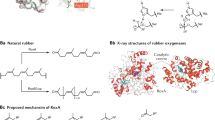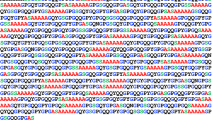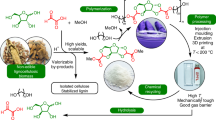Abstract
In response to problems associated with plastic waste and its effect on the environment, there has been considerable interest in the development and production of biodegradable plastics. Polyhydroxyalkanoates (PHAs) are polyesters that accumulate as inclusions in a wide variety of bacteria. These bacterial polymers have properties ranging from stiff and brittle plastics to rubber-like materials. Because of their inherent biodegradability, PHAs are regarded as an attractive source of nonpolluting plastics and elastomers that can be used for specialty and commodity products. The possibility of producing PHAs in large scale and at a cost comparable to synthetic plastics has arisen from the demonstration of PHA accumulation in transgenic Arabidopsis plants expressing the bacterial PHA biosynthetic genes. Synergism between knowledge of the enzymes and genes contributing to PHA synthesis in bacteria and engineering of plant metabolic pathways will be necessary for the development of crop plants that produce biodegradable plastics.
This is a preview of subscription content, access via your institution
Access options
Subscribe to this journal
Receive 12 print issues and online access
$209.00 per year
only $17.42 per issue
Buy this article
- Purchase on Springer Link
- Instant access to full article PDF
Prices may be subject to local taxes which are calculated during checkout
Similar content being viewed by others
References
Stein, R.S. 1992. Polymer recycling: opportunities and limitations. Proc. Natl. Acad. Sci. USA 89: 835–838.
Leaversuch, R. 1987. Industry weighs need to make polymer degradable. Modern Plastics 8: 52–55.
Lindsay, K.F. 1992. ‘Truly degradable’ resins are now truly commercial. Modern Plastics 2: 62–64.
Byrom, D. 1987. Polymer synthesis by microorganisms: technology and economics. Trends Biotechnol. 5: 246–250.
Holmes, P.A., 1988. Biologically produced (R)-3-hydroxyalkanoate polymers and copolymers, pp. 1–65. In: Development in crystalline polymers-2. D. C. Basset (Ed.). Elsevier, London.
Andersen, A. J. and Dawes, E. A. 1990. Occurence, metabolism, metabolic role, and industrial uses of bacterial polyhydroxyalkanoates. Microbiol. Rev. 54: 450–472.
Chemical marketing reporter. Vol 248. October 24 1994. Schnell Publishing Co., New York.
Steinbüchel, A. 1991. Polyhydroxyalkanoic acids. In: Novel biomaterials from biological sources. D. Byrom (Ed.). MacMillan, New York.
Poirier, Y., Dennis, D.E., Klomparens, K. and Somerville, C. 1992. Polyhydroxybutyrate, a biodegradable thermoplastic, produced in transgenic plants. Science 256: 520–523.
Poirier, Y., Dennis. D., Klomparens, K., Nawrath, C. and Somerville, C. 1992. Perspectives on the production of polyhydroxyalkanoates in plants. FEMS Microbiol. Rev. 103: 237–246.
Poirier, Y., Dennis, D. E., Nawrath, C. and Somerville, C. 1993. Progress toward biologically produced biodegradable thermoplastics. Adv. Materials 5: 30–37.
Lemoigne, M. 1926. Produit dédeshydratation et de polymérisation de l'acide β-oxybutyrique. Bull. Soc. Chim. Biol. (Paris) 8: 770–782.
Steinbüchel, A. and Schlegel, H.G. 1991. Physiology and molecular genetics of poly (β-hydroxy-alkanoic acid) synthesis in Alcaligenes eutrophus. Mol. Microbiol. 5: 535–542.
Doi, Y., Tamaki, A., Kunioka, M. and Soga, K. 1988. Production of copolyesters of 3-hydroxybutyrate and 3-hydroxyvalerate by Alcaligenes eutrophus from butyric and pentanoic acids. Appl. Microbiol. Biotechnol. 28: 330–334.
Steinbüchel, A., Debzi, E.M., Marchessault, R.H. and Timm, A. 1993. Synthesis and production of poly (3-hydroxyvaleric acid) homopolyester by Chromabacterium violaceum. Appl. Microbiol. Biotechnol. 39: 443–449.
Haywood, G. W., Anderson, A.J., Chu, L. and Dawes, E.A. 1988. Characterization of two 3-ketothiolases possessing differing substrate specificities in the polyhydroxyalkanoate synthesizing organism Alcaligenes eutrophus. FEMS Microbiol. Lett. 52: 91–96.
Haywood, G.W., Anderson, A.J., Chu, L. and Dawes, E.A. 1988. The role of NADH-and NADPH-linked acetoacetyl-CoA reductases in the poly-3-hydroxybutyrate synthesizing organism Alcaligenes eutrophus. FEMS Microbiol. Lett. 52: 259–264.
Haywood, G.W., Anderson, A.J. and Dawes, E.A. 1989. The importance of PHB-synthase substrate specificity in polyhydroxyalkanoate synthesis by Alcaligenes eutrophus. FEMS Microbiol. Lett. 57: 1–6.
Valentin, H.E., Schöebaum, A. and Steinbüchel, A. 1992. Identification of 4-hydroxyvaleric acid as a constituent of biosynthetic polyhydroxyalkanoic acids from bacteria. Appl. Microbiol. Biotechnol. 36: 507–514.
Haywood, G.W., Anderson, A.J., Williams, D.R., Dawes, E.A. and Ewing, D.F. 1991. Accumulation of a poly (hydroxyalkanoate) copolymer containing primarily 3-hydroxyvalerate from simple carbohydrate substrates by Rhodococcus sp. NCIMB 40126. Int. J. Biol. Macromol. 13: 83–88.
Williams, D.R., Anderson, A.J., Dawes, E.A. and Ewing, D.F. 1994. Production of a co-polyester of 3-hydroxybutyric acid and 3-hydroxyvaleric acid from succinic acid by Rhodococcus ruber. biosynthetic considerations. Appl. Microbiol. Biotechnol. 40: 717–723.
Lageveen, R.G., Huisman, G.W., Preusting, H., Ketelaar, P., Eggink, G. and Witholt, B. 1988. Formation of polyesters by Pseudomonas oleovorans: effect of substrates on formation and composition of poly-(R)-3-hydroxyalkanoates and poly-(R)-3-hydroxyalkenoates. Appl. Environ. Microbiol. 54: 2924–2932.
Fritzsche, K., Lenz, R.W. and Fuller, R.C. 1990. Production of unsaturated polyesters by Pseudomonas oleovorans. Int. J. Biol. Macromol. 12: 85–91.
Fritzsche, K., Lenz, R.W. and Fuller, R.C. 1990. Bacterial polyesters containing branched poly (β-hydroxyalkanoate) units. Int. J. Biol. Macromol. 12: 92–101.
Lenz, R.W., Kim, Y.B. and Fuller, R.C. 1992. Production of unusual bacterial polyesters by Pseudomonas oleovorans through cometabolism. FEMS Microbiol. Rev. 103: 207–214.
Haywood, G.W., Anderson, A.J., Ewing, D.F. and Dawes, E.A. 1990. Accumulation of a polyhydroxyalkanoate containing primarily 3-hydroxydecanoate from simple carbohydrate substrates by Pseudomonas sp. strain NCIMB 40135. Appl. Environ. Microbiol. 56: 3354–3359.
Timm, A. and Steinbüchel, A. 1990. Formation of polyesters consisting of medium-chain-length 3-hydroxyalkanoic acids from gluconate by Pseudomonas aeruginosa and other fluorescent pseudomonads. Appl. Environ. Microbiol. 56: 3360–3367.
Huijberts, G.N.M., Eggink, G., de Waard, P., Huisman, G.W. and Witholt, B. 1992. Pseudomonas putida KT2442 cultivated on glucose accumulates poly (3-hydroxyalkanoates) consisting of saturated and unsaturated monomers. Appl. Environ. Microbiol. 58: 536–544.
Saito, Y. and Doi, Y. 1993. Biosynthesis of poly (3-hydroxy-alkanoates) in Pseudomonas aeruginosa AO-232 from 13C-labeled acetate and propionate. Int. J. Biol. Macromol. 15: 287–292.
Huijbert, G.N.M., de Rijk, T.C., de Waard, P. and Eggink, G. 1994. 13C nuclear magnetic resonance studies of Pseudomonas putida fatty acid metabolic routes involved in poly (3-hydroxyalkanoate) synthesis. J. Bacteriol. 176: 1661–1666.
Ramsay, B.A., Saracovan, I., Ramsay, J.A. and Marchessault, R.H. 1992. Effect of nitrogen limitation on long-side-chain poly-β-hydroxyalkanoate synthesis by Pseudomonas resinovorans. Appl. Environ. Microbiol. 58: 744–746.
Brandl, H., Knee, E.J., Fuller, R.C., Gross, R.A. and Lenz. R. 1989. Ability of the phototrophic bacterium Rhodospirillum rubrum to produce various poly (β-hydroxyaIkanoates): potential sources for-biodegradable polyesters. Int. J. Biol. Macromol. 11: 49–55.
Liebergesell, M., Hustede, E., Timm, A., Steinbüchel, A., Fuller, R.C., Lenz, R.W. and Schlegel, H.G. 1991. Formation of poly (3 hydroxyaIkanoates) by phototrophic and chemolithotrophic bacteria. Arch. Microbiol. 155: 415–421.
Liebergesell, M.F. and Steinbüchel, A. 1993. Analysis of polyhydroxyalkanoic acid-biosynthetic genes of anoxygenic phototrophic bacteria reveals synthesis of a polyester exhibiting an unusual composition. Appl. Microbiol. Biotechnol. 40: 292–300.
Steinbüchel, A., Hustede, E., Liebergesell, M., Pieper, U., Timm, A. and Valentin, H. 1992. Molecular basis for biosynthesis and accumulation of polyhydroxyalkanoic acid in bacteria. FEMS Microbiol. Rev. 103: 217–230.
Pieper-Fürst, U., Madkour, M.H., Mayer, F. and Steinbüchel, A. 1994. Purification and characterization of a 14-kilodalton protein that is bound to the surface of polyhydroxyalkanoic acid granules in Rhodococcus ruber. J. Bacteriol. 176: 4328–4337.
Peoples, O.P. and Sinskey, A.L. 1989. Poly-β-hydroxybutyrate biosynthesis in Alcaligenes eutrophus H16: characterization of the genes encoding β-ketothiolase and acetoacetyl-CoA reductase. J. Biol. Chem. 264: 15293–15297.
Peoples, O.P. and Sinskey, A.J. 1989. Poly-β-hydroxybutyrate (PHB) biosynthesis in Alcaligenes eutrophus H16: identification and characterization of the PHB polymerase gene (phbC). J. Biol, Chem. 264: 15298–15303.
Slater, S.C., Voige, W.H. and Dennis, D.E. 1988. Cloning and expression in Escherichia coli of the Alcaligenes eutrophus H16 poly-β-hydroxybutyrate biosynthetic pathway. J. Bacteriol. 170: 4431–4436.
Schubert, P., Steinbüchel, A. and Schlegel, H.G. 1988. Cloning of the Alcaligenes eutrophus genes for synthesis of poly-β-hydroxybutyric acid (PHB) and synthesis of PHB in Escherichia coli. J. Bacteriol. 170: 5837–5847.
Fukui, T., Yoshimoto, A., Matsumoto, M., Hosokawa, S., Saito, T., Nishikawa, H. and Tomita, K. 1976. Enzymatic synthesis of poly-β-hydroxybutyrate in Zooglea ramigera. Arch. Microbiol. 110: 149–156.
Gerngross, T.U., Snell, K.D., Peoples, O.P., Sinskey, A.J., Csuhai, E., Masamune, S. and Stubbe, J. 1994. Overexpression and purification of the soluble polyhydroxyalkanoate synthase from Alcaligenes eutrophus: evidence for a required posttanslational modification for catalytic activity. Biochemistry 33: 9311–9320.
Wakil, S.J. 1989. Fatty acid synthase, a proficient multifunctional enzyme. Biochemistry 28: 4523–4530.
Gagnon, K.D., Lenz, R.W., Farris, R.J. and Fuller, R.C. 1992. Crystalliza tion behaviour and its influence on the mechanical properties of a thermoplastic elastomer produced by Pseudomonas oleovomns Macromolecules 25: 3723–3728.
Luzier, W.D. 1992. Material derived from biomass/biodegradable materials. Proc. Natl. Acad. Sci. USA 89: 839–842.
Matavulj, M. and Molitoris, H.P. 1992. Fungal degradation of polyhydroxyalkanoates and a semiquantitative assay for screening their degradation by terrestrial fungi. FEMS Microbiol. Rev. 103: 323–332.
Schirmer, A., Jendrossek, D. and Schlegel, H.G. 1993. Degradation of poly (3-hydroxyoctanoic acid) [P(3HO)] by bacteria: purification and properties of a P(3HO) depolymerase from Pseudomonas fluorescens GK13. Appl. Environ. Microbiol. 59: 1220–1227.
Müller, B. and Jendrossek, D. 1993. Purification and properties of poly (3-hydroxyvaleric acid) depolymerase from Pseudomonas lemoignei. Appl. Microbiol. Biotechnol. 38: 487–492.
Jendrossek, D., Knoke, I., Habibian, R.B., Steinbüchel, A. and Schlegel, H.G. 1993. Degradation of poly (3-hydroxyburyrate), PHB, by bacteria and purification of a novel PHB depolymerase from Comamonas sp. J. Environ. Poly. Degrad. 1: 53–63.
Jendrossek, D., Müller, B. and Schlegel, H.G. 1993. Cloning and characterization of the poly (hydroxyalkanoic acid)-depolymerase gene locus, phaZl, of Pseudomonas lemoignei and its gene product. Eur. J. Biochem. 218: 701–710.
Saito, T., Suzuki, K., Yamamoto, J., Fukui, T., Miwa, K., Tomita, K., Nakanishi, S., Odani, S., Suzuki, J.I. and Ishikawa, K. 1989. Cloning, nucleotide sequence, and expression in Escherichia coli of the gene for poly (3-hydroxybutyrate) depolymerase from Alcaligenes faecalis. J. Bacteriol. 171: 184–189.
Holland, S.J., Jolly, A.M., Yasin, M. and Tighe, B.J. 1987. Polymers for biodegradable medical devices II. Hydroxybutyrate-hydroxyvalerate copolymers: hydrolytic degradation studies. Biomaterials 8: 289–295.
Baptist, J.N. 1962. Process for preparing poly-β-hydroxybutyric acid. US Patent Application US 3044942.
Baptist, J.N. and Werber, F.X. 1965. Plasticized poly-beta-hydroxybutyric acid and process. US Patent Application US 3182036.
Byrom, D. 1990. Industrial production of copolymer from Alcaligenes eutrophus, p. 113–117. In: Novel biodegradable microbial polymers. E. A. Dawes (Ed.), Kluwer, Dordrecht.
Hrabak, O. 1992. Industrial production of poly-β-hydroxybutyrate. FEMS Microbiol. Rev. 103: 251–256.
Marchessault, R.H., Monasterios, C.J. and Lepoutre, P. 1990. Properties of poly-β-hydroxyalkanoate latex: nascent morphology, film formation and surface chemistry, p. 97–112. In: Novel biodegradable microbial polymers. E.A. Dawes (Ed.), Kluwer, Dordrecht.
Seebach, D., Roggo, S. and Zimmermann, J. 1987. Biological-chemical preparation of 3-hydroxycarboxylic acids and their use in EPC-synthesis, p. 85–126. In: Stereochemistry of organic and bioorganic transformations. W. Bartmann and K.B. Sharpless (Eds.). VCH Verlagsgesellschaft. Weinheim.
Page, W.J. 1992. Production of polyhydroxyalkanoates by Azotobacter vinelandii UWD in beet molasses culture. FEMS Microbiol. Rev. 105: 149–158.
Fidler, S. and Dennis, D. 1992. Polyhydroxyalkanoate production in recombinant Escherischia coli. FEMS Microbiol. Rev. 103: 231–236.
Zhang, H., Obias, V., Gonyer, K. and Dennis, D. 1994. Production of polyhydroxyalkanoates in sucrose-utilizing recombinant Escherichia coli and Kleb-siella strains. Appl. Environ. Microbiol. 60: 1198–1205.
De Koning, G.J.M., Van Bilesen, H.M.M., Lemstra, P.J., Hazenberg, W., Withold, B., Preusting, H., Van der Galiën, J.G., Schirmer, A. and Jendrossek, D. 1994. A biodegradable rubber by crosslinking poly (hydroxyalkanoate) from Pseudomonas oleovorans. Polymer 35: 2090–2097.
Rutenberg, M.W. and Solarek, D. 1984. Starch derivatives: production and uses, p. 311–388. In: Starch: chemistry and technology. R. L. Whistler, J. N. BeMiller and E. F. Paschall (Eds,). Academic Press, Qrlando.
Feed situation and outlook report. May 1994. U. S. Department of Agriculture.
The CRB commodity yearbook 1994. Knight-Ridder Financial Commodity Bureau. John Wiley & Sons Inc, New York.
Pryde, E.H. and Rothfus, J.A. 1989. Industrial and nonfood uses of vegetable oils, p. 87–117. In: Oil crops of the world. G. Röbbelen, R. K. Downey and A. Ashri (Eds.). McGraw-Hill, New York.
Oil crops: situation and outlook. July 1994. U. S. Department of Agriculture.
Kishore, G.M. and Somerville, C.R. 1993. Genetic engineering of commercially useful biosynthetic pathways in transgenic plants. Curr. Opin. Biotechnol. 4: 152–158.
Stark, D.M., Timmermann, K.P., Barry, G.F., Preiss, J. and Kishore, G.M. 1992. Regulation of the amount of starch in plant tissues by ADP glucose phosphorylase. Science 258: 287–292.
Voelker, T.A., Worrell, A.C., Anderson, L., Bleibaum, J., Fan, C., Hawkins, D.J., Adke, S.E. and Davies, H.M. 1992. Fatty acid biosynthesis redirected to medium chains in transgenic oilseed plants. Science 257: 72–74.
Vandekerckhove, J., VanDamme, J., Van Lijsebettens, M., Botterman, J., De Block, M., Vandewiele, M., DeClercq, A., Leemans, J., Van Montagu, M. and Krebber, E. 1989. Enkephalins produced in transgenic plants using modified 2S seed storage proteins. Bio/Technology 7: 929–932.
Sijmons, P.C., Dekker, B.M.M., Schrammeijer, B., Verwoerd, T.C., Van den Elzen, P.J.M. and Hoekema, A. 1990. Production of correctly processed human serum albumin in transgenic plants. Bio/Technology 8: 217–221.
De Zoeten, G.A., Penswick, J.R., Horisberger, M.A., Ahl, P., Schultze, M. and Hohn, T. 1989. The expression, localization, and effect of a human interferon in plants. Virology 172: 213–222.
Hodgson, J. 1992. Whole animals for wholesale protein production. Bio/Technology 10: 863–866.
Pen, J., Molendÿk, L., Quax, W.J., Sÿmons, P.C., Van Ooijen, A.J.J., Van den Elzen, P.J.M., Rietveld. K. and Hoekema, A. 1992. Production of active Bacillus licheniformis alpha-amylase in tobacco and its application in starch liquefaction. Bio/Technology 10: 292–296.
Meyerowitz, E.M. 1987. Arabidopsis thaliana. Ann Rev. Genet. 21: 93–111.
Lundgren, D.G., Pfister, R.M. and Merrick, J.M. 1964. Structure of poly-β-hydroxybutyric acid granules. J. Gen. Microbiol. 34: 441–446.
Poirier, Y., Schechtman, L.A., Satkowski, M.M., Noda, I. and Somerville, C. 1995. Synthesis of high molecular weight poly ([R]-(-)-3-hydroxybutyrate) in transgenic Arabidopsis thaliana plant cells. Int. J. Biol. Macromol 17 In press.
Nawrath, C., Poirier, Y. and Somerville, C.R. 1994. Plastid targeting of the enzymes required for the production of polyhydroxybutyrate in higher plants, p. 136–149. In: Biodegradable plastics and polymers. Y. Doi and K. Fukuda (Eds.). Elsevier, Amsterdam.
Nawrath, C., Poirier, Y. and Somerville, C. 1994. Targeting of the polyhydroxybutyrate biosynthetic pathway to the plastids of Arabidopsis thaliana results in high-levels of polymer accumulation. Proc. Natl. Acad. Sci. USA 91 In press.
World casts. Issue 121. September 16, 1994. Information Access Company, Foster City.
World casts. Issue 119. March 16, 1994. Information Access Company, Foster City.
Reusch, R. 1992. Biological complexes of poly-β-hydroxybutyrate. FEMS Microbiol. Rev. 103: 119–130.
Williams, S., Friedrich, L., Dincher, S., Carozzi, N., Kessmann, H., Ward, E. and Ryals, J. 1992. Chemical regulation of Bacillus thuringiensis δ-endotoxin expression in transgenic plants. Bio/Technology 10: 540–543.
Marchessault, R.H., Bluhm, T.L., Deslandes, Y., Harner, G.K., Orts, W.J., Sundararajan, P.R., Taylor Bloembergen, S. and Holden, D.A. 1988. Poly (β-hydroxyalkanoates): biorefinery polymers in search of applications. Makromol. Chem. Macromol. Symp. 19: 235–254.
Avella, M. and Martuscelli, E. 1988. Poly-D-(-) (3-hydroxybutyrate)/poly (ethylene oxide) blends: phase diagram, thermal and crystallization behaviour. Polymer 29: 1731–1737.
Greco, P. and Martucelli. E. 1989. Crystallization and thermal behaviour of poly (D (-)-3-hydroxybutyrate)-based blends. Polymer 30: 1475–1483.
Dave, P., Parikh, M., Reeve, M., Gross, R.A. and McCarthy, S.P. 1990. Morphological and blend miscibility effetcs on the biodegradability of poly (3-hydroxybutyrate-co-3-hydroxyvalerate) and blends. Polym. Mater. Sci. Eng. 63: 726–731.
Abe, H., Doi, Y., Satkowski, M.M. and Noda, I. 1994. Miscibility and morphology of isotactic and atactic poly (3-hydroxybutyrate). Macromolecules 27: 50–54.
De Koning, G.J.M. and Lemstra, P.J. 1993. Crystallization phenomena in bacterial poly[(R)-3-hydroxybutyrate]: 2. Embrittlement and rejuvination. Polymer 34: 4089–4094.
De Koning, G.J.M., Scheeren, A.H.C., Lemstra, P.J., Peeters, M. and Reynaers, H. 1994. Crystallization phenomena in bacterial poly[(R)-3-hydroxybutyrate]: 3. Toughening via texture changes. Polymer 35: 4598–4605.
Eggersdorfer, M., Meyer, J. and Eckes, P. 1992. Use of renewable resources for non-food materials. FEMS Microbiol. Rev. 103: 355–364.
King, P.P. 1982. Biotechnology: an industrial view. J. Chem. Tech. Biotechnol. 32: 2–8.
Mimoto, H., Barham, P.J. and Keller, A. 1988. Temperature dependence of mechanical properties of poly (β-hydroxybutyrateβ-hydroxyvalerate). Polym. Rep. 29: 112–115.
Author information
Authors and Affiliations
Rights and permissions
About this article
Cite this article
Poirier, Y., Nawrath, C. & Somerville, C. Production of Polyhydroxyalkanoates, a Family of Biodegradable Plastics and Elastomers, in Bacteria and Plants. Nat Biotechnol 13, 142–150 (1995). https://doi.org/10.1038/nbt0295-142
Issue Date:
DOI: https://doi.org/10.1038/nbt0295-142
This article is cited by
-
Biogeochemical properties of blue carbon sediments influence the distribution and monomer composition of bacterial polyhydroxyalkanoates (PHA)
Biogeochemistry (2023)
-
Commercial production of bioplastic from organic waste–derived biopolymers viz-a-viz waste treatment: A minireview
Biomass Conversion and Biorefinery (2022)
-
Stereoselective synthesis of biodegradable polymers by salen-type metal catalysts
Science China Chemistry (2022)
-
Potential of fungi isolated from the dumping sites mangrove rhizosphere soil to degrade polythene
Scientific Reports (2019)
-
Chemical synthesis of perfectly isotactic and high melting bacterial poly(3-hydroxybutyrate) from bio-sourced racemic cyclic diolide
Nature Communications (2018)



